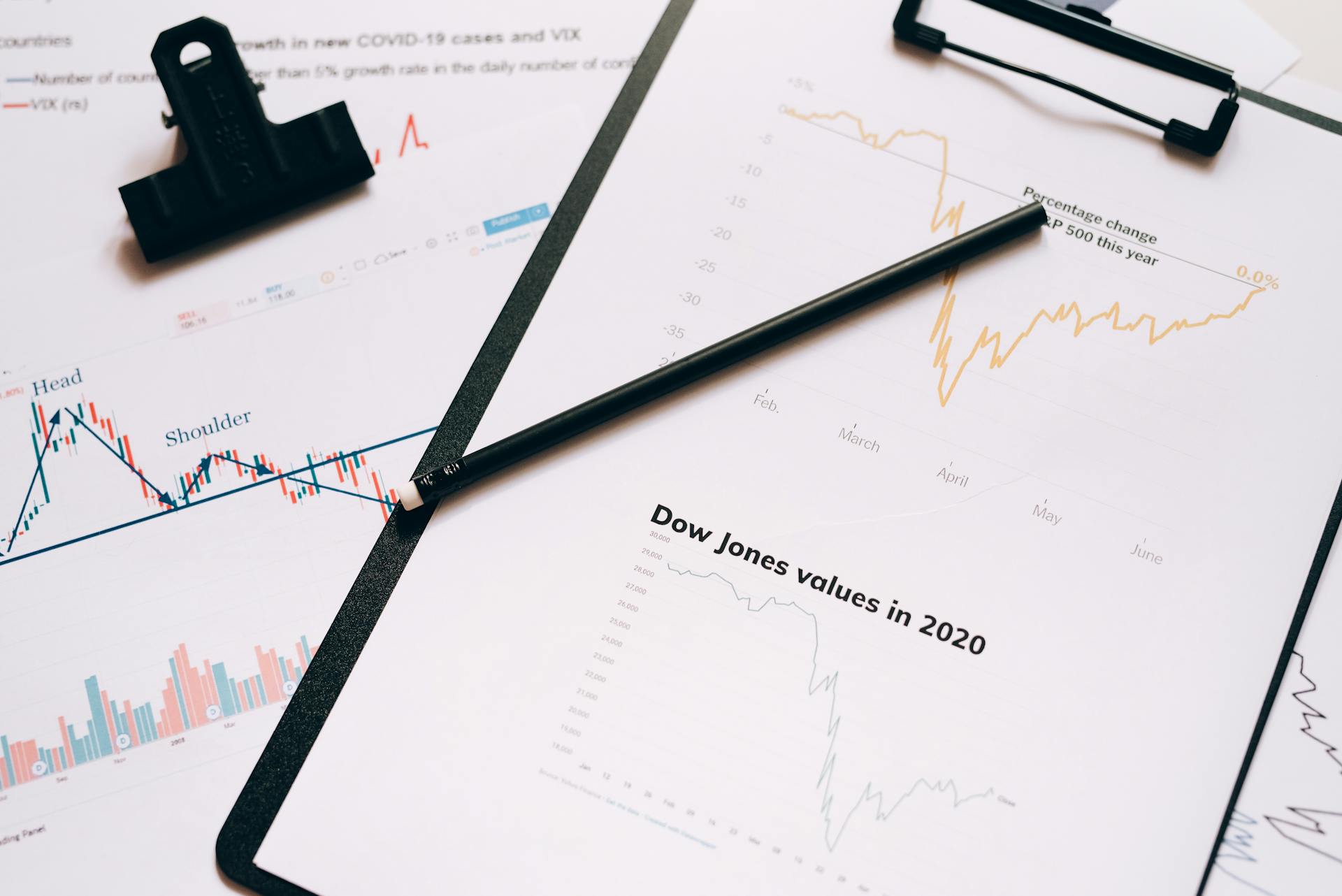
Sustainable finance is becoming a major focus in Europe, with the EU's Sustainable Finance Disclosure Regulation (SFDR) requiring financial institutions to disclose their sustainability risks and impact. The regulation applies to over 20,000 financial institutions across the EU.
The SFDR aims to increase transparency and accountability in the financial sector, which is a significant step towards a more sustainable financial system. By 2023, financial institutions will need to disclose their exposure to environmental and social risks, as well as their contribution to the EU's sustainable development goals.
The European Commission has also established the European Green Bond Standard, which provides a framework for green bonds to be issued and invested in a way that supports sustainable development. This standard is expected to increase the use of green bonds in Europe.
A fresh viewpoint: Nigerian Capital Development Fund
China's Role in Sustainable Finance
China has been a leader in sustainable finance, with a cumulative labelled green bond volume of USD489bn by the end of 2022. This is a significant milestone in the country's journey towards a low-carbon economy.
The People's Bank of China and the National Development and Reform Commission issued guidelines for green bond issuance in 2015, establishing a framework for certifying and regulating green bonds. This move ushered in a new era of green investment in China.
China has become the world's largest issuer of green bonds, with both domestic and international issuers seeking to fund environmentally friendly projects. Notable examples of issuers include the Industrial and Commercial Bank of China (ICBC), which issued a green bond worth about 6.75bn USD.
In 2016, the People's Bank of China launched a green finance pilot program in five provinces, encouraging financial institutions to support green projects and integrate ESG criteria into their lending practices. This initiative has helped to promote sustainable finance in China.
China's National Development and Reform Commission released its 14th 5-year plan on renewable energy development in June 2022, aiming to increase renewable energy generation by 50% and reduce emissions by 2.6 gigatons annually. The plan also targets a renewable energy generation of 3.3 trillion kWh by 2025.
The China Development Bank issued green bonds worth 10 billion yuan to improve the environmental protection efforts of the Yellow River and advance social development of regions. This reflects China's commitment to aligning its financial system with green development goals.
Readers also liked: Community Development Bank
European Union's Sustainable Finance Efforts
The European Union has made significant strides in sustainable finance efforts. The European Green Deal, approved in 2020, aims to make Europe climate neutral by 2050 and cut at least half of its CO2 emissions by 2030.
A major part of this plan involves raising €1 trillion in sustainable investments. The European Commission has promised to make this happen, and part of this money has been raised to finance the Next Generation EU.
The EU taxonomy regulation is a crucial milestone in the EU's agenda for sustainable finance. This regulation will help create a common language for sustainable finance, making it easier for investors to identify environmentally friendly projects.
The Network for Greening the Financial System (NGFS) was created in 2018 to explore the potential role of central banks in the energy transition. Today, it has nearly 116 central banks and supervisors, and 19 observers including the International Monetary Fund (IMF) and the European Central Bank (ECB).
The NGFS has identified several policy options for greening monetary policy instruments, including green refinancing operations, green collateral frameworks, and green quantitative easing. These options aim to encourage banks to invest in green projects and reduce their carbon footprint.
The European Investment Bank (EIB) has made green finance its top priority, with the goal of limiting global warming and adapting to the effects of climate change. The EIB provides financing to support the European Union's long-term objectives.
The Next Generation EU initiative is using green finance to finance part of its recovery plan. This initiative aims to relaunch the economy following the COVID-19 pandemic and make the European Union more sustainable, digital, and inclusive.
For another approach, see: Green Finance and the Belt and Road Initiative
Sustainable Finance Instruments
Sustainable finance comes in many shapes and forms, with debt and equity being the predominant financial instruments.
Green equities are a type of sustainable finance that involves investing in shares of companies and/or funds promoting positive environmental outcomes.
Green equities can be further divided into green companies and green funds, such as mutual and/or exchange traded funds that invest in companies with positive environment footprints.
Green debt, on the other hand, is debt instruments aimed at projects and/or companies combating climate change and environmental degradation.
This can include bonds, such as green and sustainable bonds, which are invested in projects with intended environmental goals, and sustainability-backed bonds, which are invested in projects where funding is based on achieving certain sustainable linked goals by a certain deadline.
Loans are also a type of green debt, such as green and sustainable loans, which are invested to stimulate development of environmentally-friendly services and products, and sustainability-backed loans, which are invested in projects where funding is based on achieving certain sustainable linked goals by a certain deadline.
If this caught your attention, see: Djsi Dow Jones Sustainability Index
Bonds
Bonds are a type of debt instrument that can be used for sustainable finance.
Green bonds are a subset of green debt, which is aimed at projects and/or companies combating climate change and environmental degradation.
Take a look at this: Debt Finance
Bonds can be issued in public markets to finance projects aimed at positive environmental change.
Green and sustainable bonds are a type of bond invested in projects with intended environmental goals.
Sustainability-backed bonds are bonds invested in projects where funding is based on achieving certain sustainable linked goals by a certain deadline.
Bonds like these can be directed towards renewable energy infrastructure to meet energy consumption reduction goals.
Green bonds have been particularly successful in China, where the People's Bank of China and the National Development and Reform Commission issued guidelines for green bond issuance in 2015.
The cumulative labelled green bond volume in China reached USD489bn (RMB 3.3tn) by the end of 2022.
China has become the world's largest issuer of green bonds, with both domestic and international issuers seeking to fund environmentally friendly projects.
Broaden your view: Environmental Impact of Bitcoin
Taxonomy of Activities
The taxonomy of activities is a crucial aspect of sustainable finance. It's a classification system that helps evaluate and certify "green" investments, ensuring they have a minimal impact on the environment.
In 2018, the European Commission created a working group of technical experts on sustainable finance, known as the Technical Expert Group (TEG), to develop this taxonomy. The aim is to provide a robust methodology for defining whether an activity or company is sustainable or not.
The taxonomy focuses on six key objectives: climate change mitigation, climate change adaptation, the circular economy, pollution, effect on water, and biodiversity. It's designed to prevent greenwashing and help investors make informed, greener choices.
The taxonomy came into force in July 2020 and is considered the most comprehensive and sophisticated initiative of its type. However, its effectiveness will depend on the availability of data and may take several years to become fully effective.
The classification of fossil gas and nuclear energy is a contentious issue. Some countries argue that natural gas should be considered sustainable under certain conditions, while others see it as a contradiction to climate science due to methane emissions.
Here are the six key objectives of the taxonomy:
- Climate change mitigation
- Climate change adaptation
- The circular economy
- Pollution
- Effect on water
- Biodiversity
The UK is also working on its own separate taxonomy, highlighting the importance of having a clear and consistent framework for evaluating sustainable activities.
Number of Standards
There are many different standards for measuring and reporting on sustainability performance, with no universally adopted standards in place.
The Global Reporting Initiative (GRI), IFRS Foundation, the International Integrated Reporting Council (IIRC), and the Carbon Disclosure Project are just a few of the many non-governmental organisations working to develop standards for sustainability reporting.
The IFRS Foundation is taking the lead in global standards for stock exchanges, thanks to its expertise in the standard-setting process, legitimacy in the corporate and investor community, and international regulatory support.
A new framework for sustainable finance, ISO 32210, was published in October 2022, providing guidance to organisations in the financial sector on implementing sustainability principles and terminology.
Some funds or companies claim to be green but still hold shares in oil and coal companies, highlighting the lack of universally adopted standards.
The diversity of ESG ratings methodologies can make it difficult to determine the reliability of ratings, and greenwashing threats are a concern.
Related reading: Global Alliance for Banking on Values
77% of respondents disclosing the number of ESG rating agencies they rely on use more than one provider for ESG ratings, while 23% use only one provider.
The lack of homogeneity on sustainable finance norms and standards is even larger at an international level, but initiatives like the International Platform on Sustainable Finance are working to promote international norms and standards.
Financing Transition for All
The European Investment Bank (EIB) has made limiting global warming and adapting to climate change its number one priority, devoting the bulk of its funding to this goal.
The EIB's role is to help achieve the European Union's long-term objectives through the provision of financing.
The Network for Greening the Financial System (NGFS) has nearly 116 central banks and supervisors, and 19 observers, including the International Monetary Fund (IMF) and the European Central Bank (ECB), working together to explore the potential role of central banks in accompanying the energy transition.
The NGFS has identified several policy options for greening monetary policy instruments, including green refinancing operations, green collateral frameworks, and green quantitative easing.
The EIB has committed to contributing to the Paris Agreement goals and NGFS initiatives within its mandate by taking specific actions, including integrating climate-related risks into financial stability monitoring and prudential supervision of banks.
The EIB's efforts are part of a broader push to mobilize mainstream finance and support the transition to sustainable development.
Frequently Asked Questions
What is the meaning of sustainable finance?
Sustainable finance combines financial decisions with environmental, social, and governance considerations to support long-term, eco-friendly investments. It's a forward-thinking approach to investing that prioritizes the well-being of both people and the planet.
Is sustainable finance the same as ESG?
Sustainable finance and ESG (Environmental, Social, and Governance) are related but not exactly the same thing, with sustainable finance being a broader approach that incorporates ESG considerations into investment decisions. ESG is a key component of sustainable finance, but it's not the only factor involved.
What are the five pillars of sustainable finance?
The five pillars of sustainable finance are Pillar 1: Definition, Pillar 2: Selection, Pillar 3: Traceability, Pillar 4: Transparency, and Pillar 5: Accountability, which together form a framework for responsible investment and management of funds. Understanding these pillars is crucial for making informed decisions about sustainable finance.
Sources
- https://en.wikipedia.org/wiki/Sustainable_finance
- https://kpmg.com/us/en/articles/2023/defining-sustainable-finance.html
- https://www.eib.org/en/stories/what-is-sustainable-finance
- https://www.worldbank.org/en/topic/financialsector/brief/sustainable-finance
- https://unglobalcompact.org/sdgs/sustainablefinance
Featured Images: pexels.com


